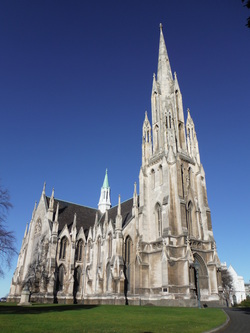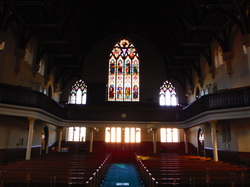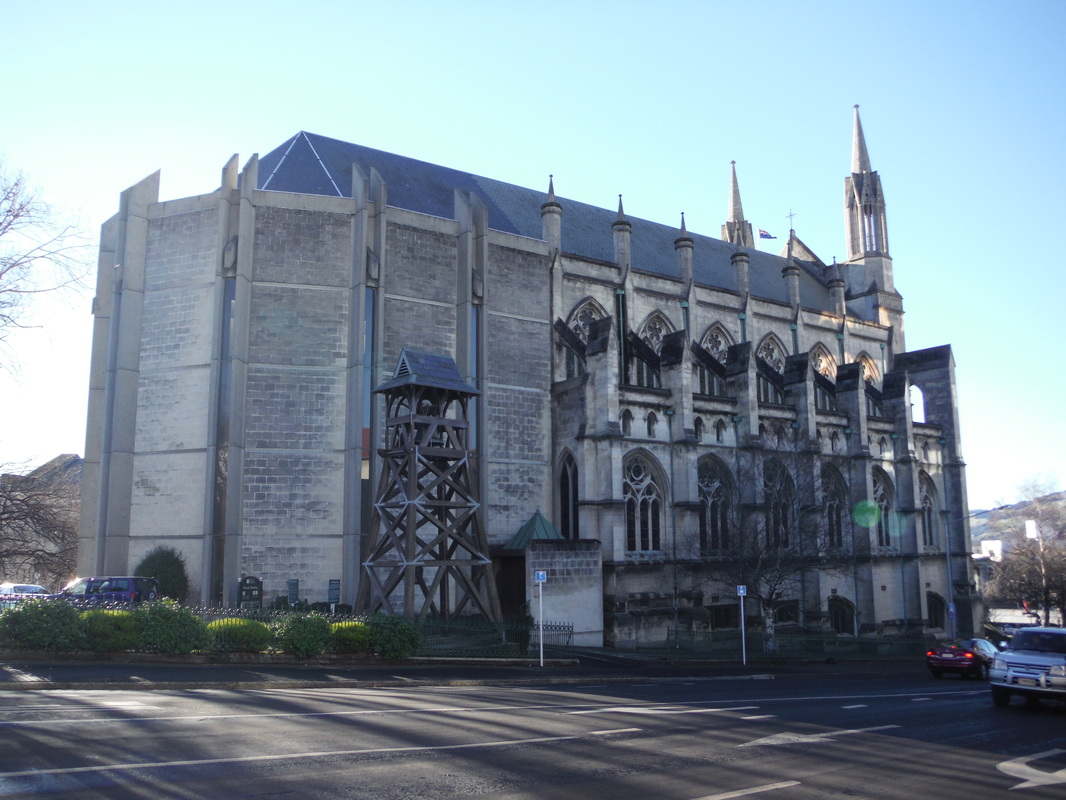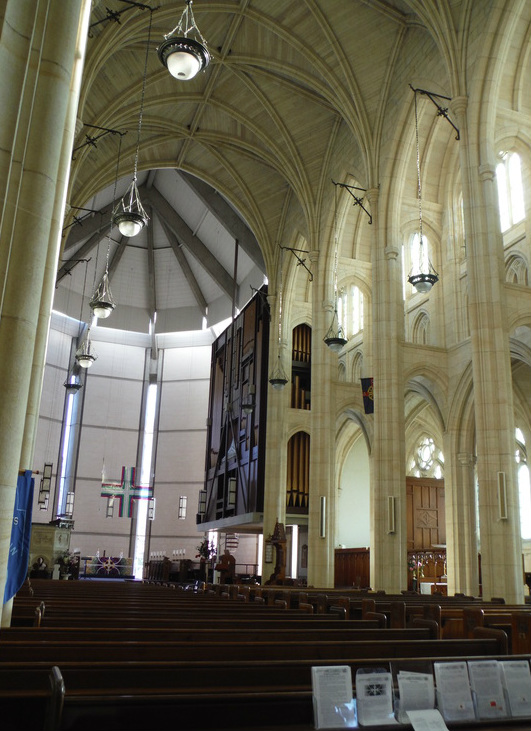I went exploring in town and found three major churches/cathedrals: The First Church of Otago, St. Paul's Cathedral, and Knox Church. Churches are one of my favorite places to visit. I am not religious anymore, so churches, to me, are architecture. They are beautiful pieces of artwork that you cannot just look at, but must enter and experience.
If you are going to read this post without any knowledge of the architectural language of churches and cathedrals, here is a slideshow describing some basics and some of the specific details I will talk about. The floor plan is the most important.
 The First Church of Otago - Presbyterian
The First Church of Otago - Presbyterian This was the first church that I visited. To find it, I just followed the steeple peeking out over the tops of all the buildings. I literally turned around a corner and this beautiful sight greeted me. The church was reminiscent of the Gothic style, with the tall steeple, a central spire, pointed archways, buttresses, stained glass, a grand facade, and details that draw your eyes upwards. The layout even seemed very Gothic. There is a very clear nave, transept, and--when looking around back--there was even evidence of an apse (the large half circle where the altar usually is) with three little chapels (small half-circle rooms connected to the apse). I could not wait to go inside!
When I walked in past the entryway, I was shocked. There was no sense of largeness, of reaching towards the heavens, and half of the church that I could see from the outside was missing! The lack of space was due to a downward sloping balcony that you enter underneath. It instantly closed you off. But after walking into the transept, the openness was elating.
When I walked in past the entryway, I was shocked. There was no sense of largeness, of reaching towards the heavens, and half of the church that I could see from the outside was missing! The lack of space was due to a downward sloping balcony that you enter underneath. It instantly closed you off. But after walking into the transept, the openness was elating.
As you can see, the interior (besides lacking the exterior apse and choirs) continued along the semi-Gothic architecture. The ceilings were vaulted, the natural light from the stained glass windows filled the church, and I felt like I was floating in open air. Unfortunately, I did have to try and look up. The balcony covered nave and lack of columns to support either the aisles or vaulted ceilings did not instantly draw my eyes upwards. But overall, it was a beautiful, though slightly modern, inside. The entryway did have some wonderful stone work, though.
 The Transept and Nave of Knox Church.
The Transept and Nave of Knox Church. Very similar to The First Church was the Knox church. Slightly Gothic, vaulted ceilings, open space, modern inside, a balcony that ruined the entrance, etc. Actually, if you put together the transept shot from The First Church, with the Transept/Nave shot of Knox Church, you have a pretty good idea of what the complete interior of each looked like.
The major differences between Knox Church and The First Church is that: the balcony extended all the way to the apse at the Knox church and the main entrance of Knox church was on the side of the church, not the back center.
The major differences between Knox Church and The First Church is that: the balcony extended all the way to the apse at the Knox church and the main entrance of Knox church was on the side of the church, not the back center.
Finally, I visited St. Paul's Cathedral. Now this, everyone, is a wonderful example of a Cathedral. It doesn't come nearly as close to the beautiful churches and cathedrals around every street corner in France, but it is close. From the outside, you can clearly see a nave and apse (with the lack of a transept). There are beautiful spires, flying buttresses, large stained glass in pointed arch windows. There's even evidence of a clerestory (the highest set of windows), a triforium (the mini windows in the middle), and an arcade (the large windows on the ground level)! The only odd part about this cathedral is that is is oriented West to East--instead of East to West--due to the fact that it is on a huge hill.
Anyways, the interior of this cathedral was open, inviting, and drew my head towards the heavens. But before I get to the architecture, I want to talk about the wonderful cathedral secretary I met. I was asking a question about why some of the windows had pictures and the others didn't. She explained that many of them are still in the process of being made. As they get the money, they create a new window (the newest one is a Dunedin window!). But, she picked up on my accent and asked where I was from. When I replied with, America, Pennsylvania. She went on to tell me about when she had visited! She got to touch the Liberty Bell. And she visited the Amish in Lancaster. It's a small world, and I don't quite realize how popular my state can be!
Anyways, the inside was gorgeous, complete with a long, open nave, aisles on the side that were supported by large columns, large pointed archways, bright stained glass windows letting in colorful natural light, and a modern (but still stylized and beautiful) apse. It was odd, seeing the apse with a different color stone, modern windows that went floor to ceiling, and a less vaulted ceiling. But, it fit.
I was also pleased to find an area where people could light candles. When I was in France, every church and cathedral had this option, and I kept up my tradition of lighting one. In France, I lit a candle for my great-grandmother because she was one of the people most excited to see me go to France and she passed away before I left. So, the candle I lit was for her.
Anyways, the inside was gorgeous, complete with a long, open nave, aisles on the side that were supported by large columns, large pointed archways, bright stained glass windows letting in colorful natural light, and a modern (but still stylized and beautiful) apse. It was odd, seeing the apse with a different color stone, modern windows that went floor to ceiling, and a less vaulted ceiling. But, it fit.
I was also pleased to find an area where people could light candles. When I was in France, every church and cathedral had this option, and I kept up my tradition of lighting one. In France, I lit a candle for my great-grandmother because she was one of the people most excited to see me go to France and she passed away before I left. So, the candle I lit was for her.
All in all, I highly suggest taking a History of Art course if you ever come across one. The information you learn stays with you, comes in handy (Jeopardy! answers galore), and helps you appreciate the beauty found in the world around you. Also, in case you didn't notice, the title is a Doctor Who reference--even if I did find a bell outside the St. Paul's Cathedral.




 RSS Feed
RSS Feed